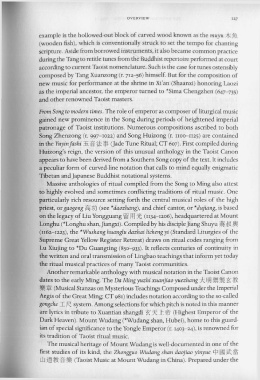Page 167 - The Encyclopedia of Taoism v1_A-L
P. 167
OV E RVI EW 127
example is the hollowed-out block of carved wood known as the muyu If: m.
(wooden fish), which is conventionally struck to set the tempo for chanting
scripture. Aside from borrowed instruments, it also became common practice
during the Tang to retide tunes from the Buddhist repertoire performed at court
according to current Taoist nomenclature. Such is the case for tunes ostensibly
composed by Tang Xuanzong (r. 712-56) himself. But for the composition of
new music for performance at the shrine in Xi'an (Shaanxi) honoring Laozi
as the imperial ancestor, the emperor turned to *Sima Chengzhen (647- 735)
and other renowned Taoist masters.
From Song to modern times. The role of emperor as composer of liturgical music
gained new prominence in the Song during periods of heightened imperial
patronage of Taoist institutions. Numerous compositions ascribed to both
Song Zhenzong (r. 997-1022) and Song Huizong (r. nOO-II25) are contained
in the Yuyin fashi ~ if 1~ $ (Jade Tune Ritual; CT 607). First compiled during
Huizong's reign, the version of this unusual anthology in the Taoist Canon
appears to have been derived from a Southern Song copy of the text. It includes
a peculiar form of curved-line notation that calls to mind equally enigmatic
Tibetan and Japanese Buddhist notational systems.
Massive anthologies of ritual compiled from the Song to Ming also attest
to highly evolved and sometimes conflicting traditions of ritual music. One
particularly rich resource setting forth the central musical roles of the high
priest, or gaogong i'a:J:rj] (see *daozhang), and chief cantor, or *dujiang, is based
on the legacy of Liu Yongguang m ffl :Jlt (n34-I206), headquartered at Mount
Longhu (*Longhu shan, Jiangxi). Compiled by his disciple Jiang Shuyu ~ ~_
(n 62- I223), the *Wushang huanglu dazhai licheng yi (Standard Liturgies of the
Supreme Great Yellow Register Retreat) draws on ritual codes ranging from
Lu Xiujing to *Du Guangting (850-933). It reflects centuries of continuity in
the written and oral transmission of Lingbao teachings that inform yet today
the ritual musical practices of many Taoist communities.
Another remarkable anthology with musical notation in the Taoist Canon
dates to the early Ming. The Da Ming yuzhi xuanjiao yuezhang "* BA ~~ K t9:
~ ~ (Musical Stanzas on Mysterious Teachings Composed under the Imperial
Aegis of the Great Ming; CT 981) includes notation according to the so-called
gongche IR system. Among selections for which pitch is noted in this manner
are lyrics in tribute to Xuantian shangdi K7(~.'* (Highest Emperor of the
Dark Heaven). Mount Wudang (*Wudang shan, Hubei), home to this guard-
ian of special significance to the Yongle Emperor (r. 1403-24), is renowned for
its tradition of Taoist ritual music.
The musical heritage of Mount Wudang is well-documented in one of the
first studies of its kind, the Zhongguo Wudang shan daojiao yinyue 9=t ~ iE\:; 'I
ill mt9:if~ (Taoist Music at Mount Wudang in China). Prepared under the

